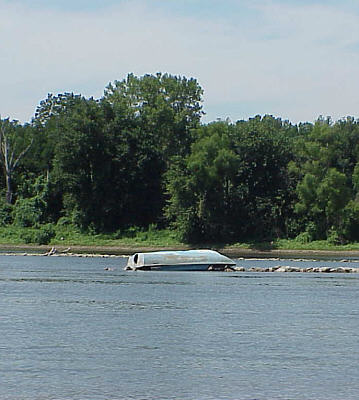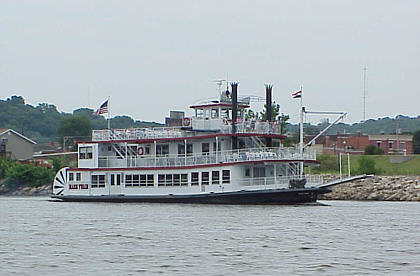| Page 4
 Obviously, from time to time I do dumb things but I at least try to learn
from the experience. So now here are those same chart markings and
I really am not in the mood to try to “feel” my way in to one of there areas.
All I need to do is loose a prop and let the high current dump me into an
even worse situation with no control of the boat. No, I decide I was
going to spend the night on the main channel.
Obviously, from time to time I do dumb things but I at least try to learn
from the experience. So now here are those same chart markings and
I really am not in the mood to try to “feel” my way in to one of there areas.
All I need to do is loose a prop and let the high current dump me into an
even worse situation with no control of the boat. No, I decide I was
going to spend the night on the main channel. South of St. Louis this is no problem. The majority wing dams are normally above the surface so you can just tuck in behind one of them. Protected from the current it makes a great place to hang on the hook. But here they are under the surface and this makes the current coming over them even stronger. (Photo shows what happens when you don't pay attention to wing dams.) I spotted a nice sand bar and decided to check it out. The easy thing would be just to shove the bow up hard on to the sand and bury the anchor up on the bank. But I hesitated to do this. If you look under my Bayliner you will see places that no longer have any gel coat. Hours of sitting on sand bars and bouncing in the waves have ground away the finish. And gel coat is a bunch tougher than my paint. I decided I would drop anchor just off the shore and allow Therapy to float. The current will hold her parallel to the bank. But still the current is heavy and I am concerned about my anchor holding. If there is any current at all I always drop two anchors but because of my earlier experience with anchors not holding I decided to drag one up onto the sandbar and bury it in the sand. Surely, that will take care of the problem. But as I settle into the berth I start thinking about the raw power of the current. What if wake from a passing barge rocks me loose and as I blissfully sleep while floating into the path of another one? Yes, I am probably OK but don’t think I am going to sleep too well with that thought on my mind. I need an anchor alarm. In fact, my GPS has such a function and if set will sound a warning if the boat moves a certain distance. Problem is the high-pitched chirp it omits is beyond the hearing range of my 50-year-old ears. I decide to improvise. I dig out my stainless steel prop and attach a piece of lightweight rope. I drop the prop overboard and let it settle to the bottom. To the other end of the line I attach my D-cell flashlight and place it on the helm seat. My thought is if the anchors fail and I start drifting the flashlight would be pulled off on to the deck making enough noise to wake me.  Confident I have taken more than enough precautions I crawl back into
the berth and relax with a book. About and hour later a tow lumbers
by and suddenly the flashlight hits the deck. I scramble out and find
it is a false alarm as the anchors are still holding tight. I just had
the line to the light too short and the movement caused by the wake pulled
it off. But that’s good. Now I can rest a little better knowing
my crude alarm does work but I try not to think about the fact that I am using
a $450 propeller for an anchor! I crawl back in and decide it is time
for lights out.
Confident I have taken more than enough precautions I crawl back into
the berth and relax with a book. About and hour later a tow lumbers
by and suddenly the flashlight hits the deck. I scramble out and find
it is a false alarm as the anchors are still holding tight. I just had
the line to the light too short and the movement caused by the wake pulled
it off. But that’s good. Now I can rest a little better knowing
my crude alarm does work but I try not to think about the fact that I am using
a $450 propeller for an anchor! I crawl back in and decide it is time
for lights out.(Photo is of excursion boat working the waters near Hannibal, MO) But now a loud blast wakes me from a sound sleep at about 3:30 am. It is the lightning and thunder I mentioned at the beginning of this saga. Sitting at the helm I try to weigh my situation. First off, the sandbar is relatively low and Therapy may be the highest point in the immediate area. Plus, if the wind kicks up I question as to whether the anchor will hold. I decide it is time to move. The clouds obscure the full moon but still it is creating enough light I can distinguish the shoreline. I had checked the chart earlier and know there were no wing dams on this side of the river for at least a mile so I decided to ease my way downstream to look for a safer location. About a half mile down I find a narrow sand covered shoreline with large overhanging sycamore trees. I decide the heck with the paint and run it on to the shore. I walk around to the bow and heave the anchor up into the trees where it snags something solid. Good enough. I crawl back into the sack.  The strong lightning storm hangs around until about 7 am.
I get one short downpour of rain but never any wind. When I finally
feel it is safe, I shove Therapy off the bank and continue south.
The first lock of the day is only about 12 miles away and I arrive finding
I have an hour and a half wait. Another normal day on the river….
The strong lightning storm hangs around until about 7 am.
I get one short downpour of rain but never any wind. When I finally
feel it is safe, I shove Therapy off the bank and continue south.
The first lock of the day is only about 12 miles away and I arrive finding
I have an hour and a half wait. Another normal day on the river….The remainder of the trip is pleasantly uneventful. I pull into Alton Marina at about 5:00 pm tired and hungry but happy. It has been a nice trip. The GPS shows I have covered 648 miles in my four days out. My fuel consumption has been 72 gallon so my MPG was right at 9, which is normal for my Cabin Skiff. When I check the total log numbers I see that Therapy now has had 8156 miles pass under her bow and the 50 HP Honda has run for 512 hours. Not too bad for two years of knocking around on the water. But now it is time to get back home and roll Therapy back in the shed. After all, this trip is over so it is time to start planning the next one! |